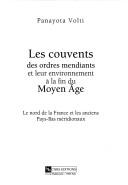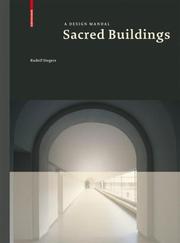| Listing 1 - 3 of 3 |
Sort by
|

ISBN: 2271061636 227109092X 9782271061638 Year: 2003 Publisher: Paris: CNRS,
Abstract | Keywords | Export | Availability | Bookmark
 Loading...
Loading...Choose an application
- Reference Manager
- EndNote
- RefWorks (Direct export to RefWorks)
The mendicant orders, essential agents of the spirituality of the last centuries of the Middle Ages, are intimately linked to their inhabited universe: their convents. Based on their own structural, aesthetic and functional principles, these architectural complexes with a clearly polyvalent vocation, responding to the religious, community and intellectual activities of the religious as well as to the needs of the faithful, constituted the edifying counterpoint of the apostolic activity and the pattern of life of beggars. Deliberately settled in urban environments, they created decisive bridges with the outside world, thus opening up their establishments, which, because of their thoughtful establishment, were able to integrate and adapt dynamically in reception areas. The frequent foundations of the convents in the sensitive areas of the cities and the creation, in the churches and in the conventual buildings, of suitable spaces and architectural arrangements satisfied, sometimes even preceded, the spiritual aspirations, even social, of the flocks. This study, combining archaeological data with information provided by archives, historical sources and ancient graphic documents, embraces the female and male convents of the four main begging orders: Dominicans, Franciscans, Carmelites and Augustinians. Moreover, in the geographical area chosen, namely the north of France and the former Southern Netherlands, the conventual architecture had until then been little explored.
Christian religious orders --- anno 1200-1499 --- Belgium --- Netherlands --- France: North --- Convents --- Friars --- Couvents --- Ordres mendiants --- History --- Histoire --- France --- Belgique --- Church history --- Histoire religieuse --- Monasteries --- Monasticism and religious orders --- History. --- 271.025 <44> --- 271.025 <493> --- 271 "13" --- 726.7 <44> --- 726.7 <493> --- Bedelorden--Frankrijk --- Bedelorden--België --- Kloosterwezen. Religieuze orden en congregaties. Monachisme--?"13" --- Abdijen. Kloosters--Frankrijk --- Abdijen. Kloosters--België --- 726.7 <493> Abdijen. Kloosters--België --- 726.7 <44> Abdijen. Kloosters--Frankrijk --- 271.025 <493> Bedelorden--België --- 271.025 <44> Bedelorden--Frankrijk --- Monachism --- Monastic orders --- Monasticism and religious orders for men --- Monasticism and religious orders of men --- Orders, Monastic --- Orders, Religious --- Religious orders --- Brotherhoods --- Christian communities --- Brothers (Religious) --- Monks --- Superiors, Religious --- Cloisters (Religious communities) --- Friaries --- Church property --- Religious institutions --- Scriptoria --- Mendicant orders --- Christians --- Convents and nunneries --- Nunneries --- Monasticism and religious orders for women --- Europe --- Middle Ages, 600-1500 --- Middle Ages, 500-1500 --- Convents - France, Northern - History. --- Convents - Belgium - History. --- Monasteries - France, Northern - History. --- Monasteries - Belgium - History. --- Friars - France, Northern - History. --- Monasticism and religious orders - France, Northern - History. --- Monasticism and religious orders - Belgium - History. --- couvent --- ordre mendiant --- Pays-Bas --- architecture --- COUVENTS --- MONACHISME ET ORDRES RELIGIEUX --- ORDRES MENDIANTS --- ARCHITECTURE RELIGIEUSE --- EUROPE --- FRANCE --- MOYEN AGE --- PAYS BAS --- VILLES
Book
ISBN: 9461662602 9789461662606 9789462701434 9462701431 Year: 2018 Volume: 21 Publisher: Leuven : Leuven University Press,
Abstract | Keywords | Export | Availability | Bookmark
 Loading...
Loading...Choose an application
- Reference Manager
- EndNote
- RefWorks (Direct export to RefWorks)
Sacred architecture as reality and metaphor in secularised Western society.00Christian monasteries and convents, built throughout Europe for the best part of 1,500 years, are now at a crossroads. This study attempts to understand the sacred architecture of monasteries as a process of the tangible and symbolic organisation of space and time for religious communities. Despite the weight of seemingly immutable monastic tradition, architecture has contributed to developing specific religious identities and played a fundamental part in the reformation of different forms of religious life according to the changing needs of society. The cloister is the focal point of this book because it is both architecture, a physically built reality, and a metaphor for the religious life that takes place within it. Life Inside the Cloister also addresses the afterlife and heritagisation of monastic architecture in secularised Western society.
Cloisters (Architecture) --- Monastic and religious life --- Monastic life --- Spirituality (in religious orders, congregations, etc.) --- Monasticism and religious orders --- Spiritual life --- Vows --- Architecture --- Courtyards --- Christianity --- 235.4 --- Kloosters--geschiedenis --- Kloosterleven--geschiedenis --- C3 --- religieuze kunst --- architectuur --- kloosters --- KADOC - Documentatie- en Onderzoekscentrum voor Religie, Cultuur en Samenleving (1977-) --- Academic collection --- 726.7 --- Religieuze architectuur ; kloosters ; abdijen --- Kunst en cultuur --- Religieuze architectuur ; abdijen, kloosters --- Religious architecture --- monasteries [built complexes] --- religieuze architectuur --- geschiedenis

ISBN: 9783764366834 3764366834 9783764366841 1299864449 3764382767 3764388196 9783764382766 3034609744 9783034609746 3764366842 3764388188 Year: 2008 Publisher: Basel ; Boston : Birkhauser,
Abstract | Keywords | Export | Availability | Bookmark
 Loading...
Loading...Choose an application
- Reference Manager
- EndNote
- RefWorks (Direct export to RefWorks)
The building of religious structures represents a rare opportunity for the architect to concentrate on the creation of volume, space, and form. Sacred architecture is far less determined than other building tasks by functional requirements, norms, and standards. As a rule, it is free to unfold as pure architecture. Thus in design terms this building task offers enormous freedoms to the architect. At the same time, however, the special atmospherics of sacred spaces call, on the part of the architect, for a highly sensitive treatment of religion and the relevant cultural and architectural traditions. In a systematic section, this volume introduces the design, technical, and planning fundamentals of building churches, synagogues, and mosques. In its project section, it also presents about seventy realized structures from the last three decades. Drawing upon his in-depth knowledge of the subject and his many years of publishing experience, the author offers a valuable analysis of the conceptual and formal aspects that combine to create the religious impact of spaces (e.g., the ground plan, the shapes of the spaces, the incidence of light, and materiality).
Religious architecture --- Architecture religieuse --- Designs and plans --- Dessins et plans --- Electronic books. -- local. --- Religious architecture -- Design and construction. --- Religious architecture. --- 726 --- 726.5 --- 726.7 --- 726.3 --- 726.2 --- 726.8 --- 72.036 --- 72.037 --- Religieuze architectuur --- Kerkelijke bouwkunst --- Kerken (architectuur) --- Kapellen (architectuur) --- Kloosters (architectuur) --- Synagogen --- Moskeeën --- Crematoria --- Funeraire architectuur --- 20ste eeuw (architectuur) --- Twintigste eeuw (architectuur) --- 21ste eeuw (architectuur) --- Eenentwintigste eeuw (architectuur) --- 726(035) --- Religieuze architectuur ; handboeken --- Spiritual architecture --- Architecture --- Design and construction --- Church architecture. --- Ecclesiastical architecture --- Rood-lofts --- Christian art and symbolism --- Architecture, Gothic --- Church buildings --- Buildings. --- Religious architecture -- Planning. --- Sacred building -- Building design. --- Art, Architecture & Applied Arts --- Design and construction.
| Listing 1 - 3 of 3 |
Sort by
|

 Search
Search Feedback
Feedback About UniCat
About UniCat  Help
Help News
News